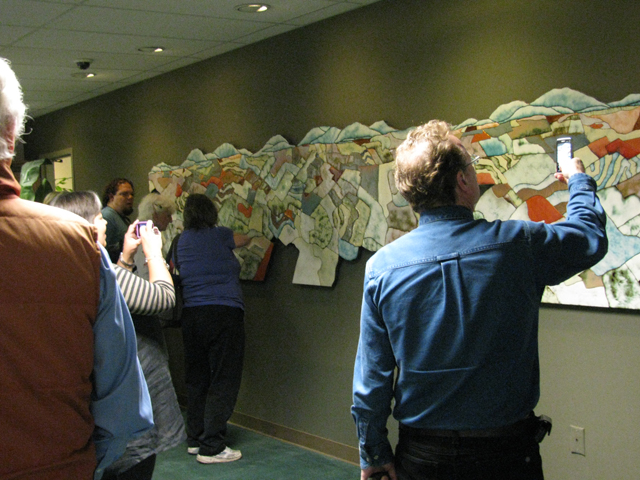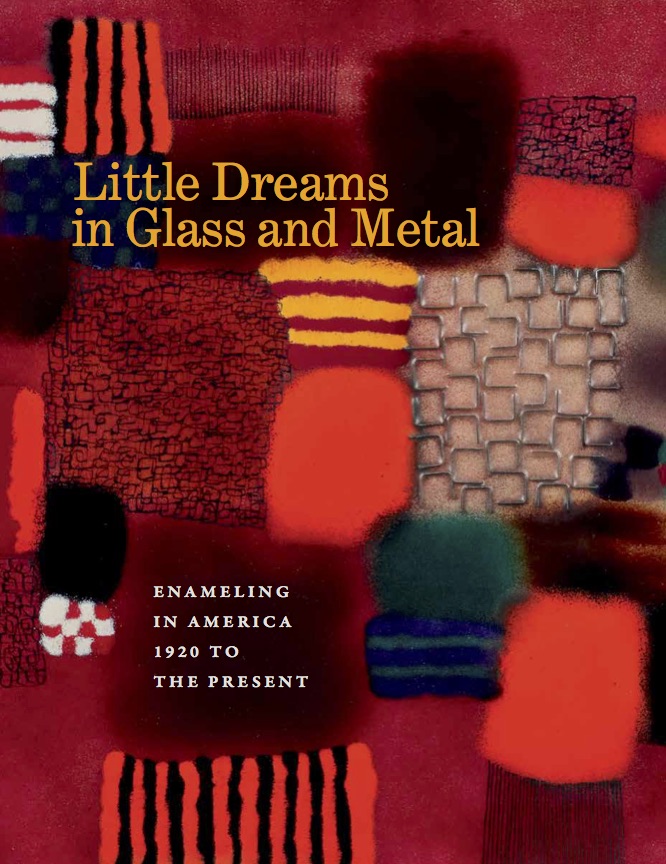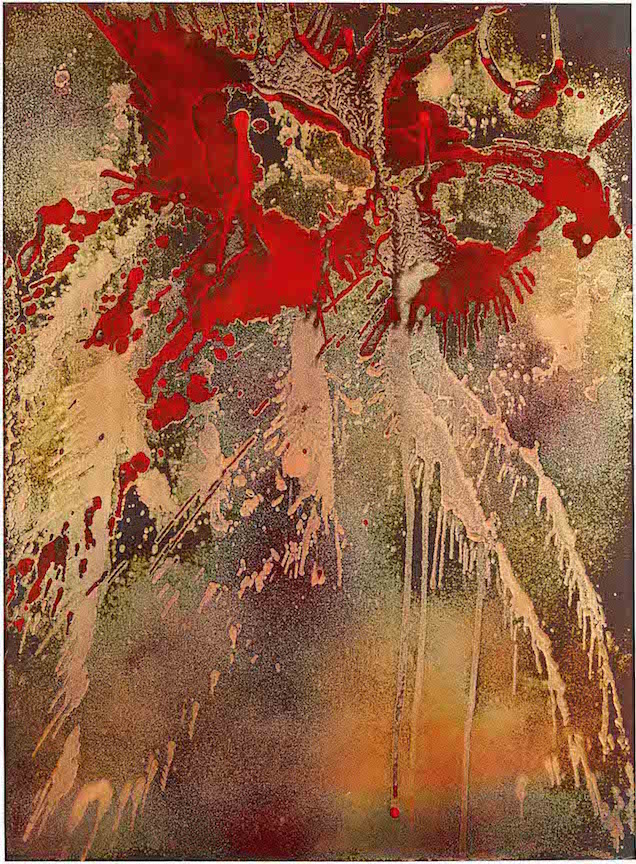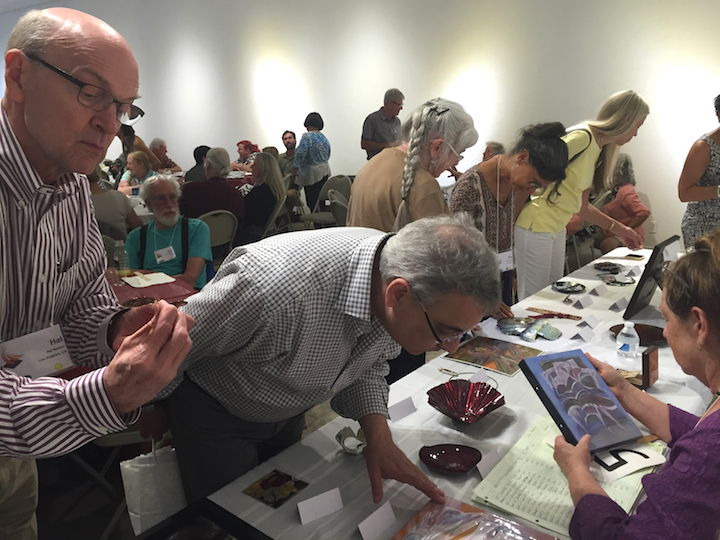This is the second of our two-part series, Challenges and Opportunities for Artists Who Choose Enamel, an essay by our intern Zhou Zoe Yuan. You can read the first part here.
We welcome comments on this article! Do you agree with the challenges and opportunities described here? What has your own experience been? Post in the comments section below or write us at

Visitors admire “Valley Fields,” a large-scale wall installation by Fred Ball, at Raley’s corporate headquarters in Sacramento, CA.
Enamel Exhibitions – Where Are They?
In addition to the dearth of educational resources, another major obstacle facing contemporary enamelists is how little visibility the medium has. There are few opportunities to exhibit at the national level, in museums and galleries. As Bernard Jazzar and Harold Nelson note,[6] the last major museum shows featuring enamel disappeared by the 1970s, as “the fundamental institutional support that had sustained [enameling] in its early years began to erode,” and the curators that had championed enamel in its heyday were replaced.
Enameling organizations are expending great effort to reverse the tide. The Enamelist Society, one of the most active organizations, has sponsored the Biennial International Juried Enamel Exhibition for decades. The Los Angeles-based Enamel Arts Foundation is also one of the leaders in the field. In 2007, Nelson, former director of the Long Beach Museum of Art, and Jazzar, co-founder with Nelson of the Enamel Arts Foundation, organized the exhibition Painting with Fire: Masters of Enameling in America, 1930-1980, and published the book with the same title. This year, EAF has organized a traveling exhibition, Little Dreams in Glass and Metal: Enameling in America 1920 to the Present, which includes a wide range of enameled objects, from wearable jewelry to large enamel-on-steel wall pieces from the foundation’s collection.[7] Mounted first at the Fuller Craft Museum, the exhibition received an extraordinary review in the Boston Globe.
Works of History and Criticism – Where Are They?
 With one or two notable exceptions, there have been very few books about U. S. enameling published in the last century. Those that exist, focus mainly on techniques. As Doran mentioned, these books are useful for teaching an introductory level of enameling.[8] But they won’t help educate the general public about enamel’s importance as an art form. Painting with Fire was, as the authors note on the cover, “the first book ever published to explore the field of twentieth-century enameling in this country from a historical rather than a technical perspective.”[9] The book was a great breakthrough and now is followed by Little Dreams which, like Painting with Fire, is a book with historical content. The next step should be the publication of critical writings on enameling, which would help artists think about how to incorporate this medium in their art practice, as well as provide a lay readership with a better understanding and broader context.
With one or two notable exceptions, there have been very few books about U. S. enameling published in the last century. Those that exist, focus mainly on techniques. As Doran mentioned, these books are useful for teaching an introductory level of enameling.[8] But they won’t help educate the general public about enamel’s importance as an art form. Painting with Fire was, as the authors note on the cover, “the first book ever published to explore the field of twentieth-century enameling in this country from a historical rather than a technical perspective.”[9] The book was a great breakthrough and now is followed by Little Dreams which, like Painting with Fire, is a book with historical content. The next step should be the publication of critical writings on enameling, which would help artists think about how to incorporate this medium in their art practice, as well as provide a lay readership with a better understanding and broader context.

Paul Hultberg, Lepidopteral Pyrotechnics, 1965. Enamel on copper. 24″ x 18″. Collection of the Enamel Arts Foundation.
The Supply Dilemma
The shortage of enameling suppliers, both online and as brick-and-mortar stores, is an obstacle for enamelists as well. Not many distributors in the U.S. sell Thompson enamel, the sole manufacturer of “jewelry” enamels in North America. Even fewer distributors sell imported enamels and enameling supplies. Probably the primary source of enamels today is through online suppliers, which are extremely convenient but in the end a poor substitute for actual stores.
Is the Best Yet to Come?

The connections we build through social media, classes, and outreach will make the enameling community stronger. Kat Cole, Double Box Brooch with Chain.
And yet as a way to network and foster partnerships, and make this hidden community visible, the internet has no equal. While it cannot replace live conferences and meetings as a way to connect with other artists and share ideas, social media is a tremendously effective way for enamelists to connect. There are Facebook groups for guilds and organizations, Etsy groups, blogs, newsgroups, and more for enamelists to share their own works, get feedback, help each other and learn. Enamel artists all over the country, once isolated in their studios, can be found by searching enameling hashtags on Twitter and Instagram. A thriving nationwide community of enamel artists, old and young, was Doran’s “great expectation” in 1995, as it still is for all artists who are passionate about this medium.
As an old art medium, enamel has had a hard time finding its place in the 21st century. And yet there is avid interest, including among the newest generation of artists, and there is a core group of enamelists who are dedicated to keeping the art alive and pushing its boundaries. By continuing to explore new directions, strengthening and expanding the enameling community, and contributing to a vibrant critical conversation, we can create a true renaissance.
Bibliography
Doran, James. “Artists Who Choose Enamel.” Glass on Metal. December, 1995.
Goss, Gretchen and Maria Phillips. “Enamel: A Current Perspective”. Sculptural Object Functional Art and Design. http://www.sofaexpo.com/chicago/essays/2003/enamel-a-current-perspective. (accessed June 5, 2015)
Jazzar, Bernard N. and Harold B. Nelson. Little Dreams in Glass and Metal: Enameling in America, 1920 to the Present. Los Angeles: Enamel Arts Foundation, distributed by the University of North Carolina Press, 2015.
Jazzar, Bernard N. and Harold B. Nelson. Painting with Fire: Masters of Enameling in America, 1930-1980. Long Beach Museum of Art, 2006.
Footnotes
[6] Jazzar and Nelson, Painting With Fire, p. 181.
[7] Fuller Craft Museum. “Little Dreams in Glass and Metal: Enameling in America 1920 to the Present”. http://fullercraft.org/event/little-dreams-in-glass-and-metal-selections-from-the-enamel-arts-foundation/.
[8] Doran, p. 132.
[9] Jazzar and Nelson, Painting With Fire, back cover.


Recent Comments